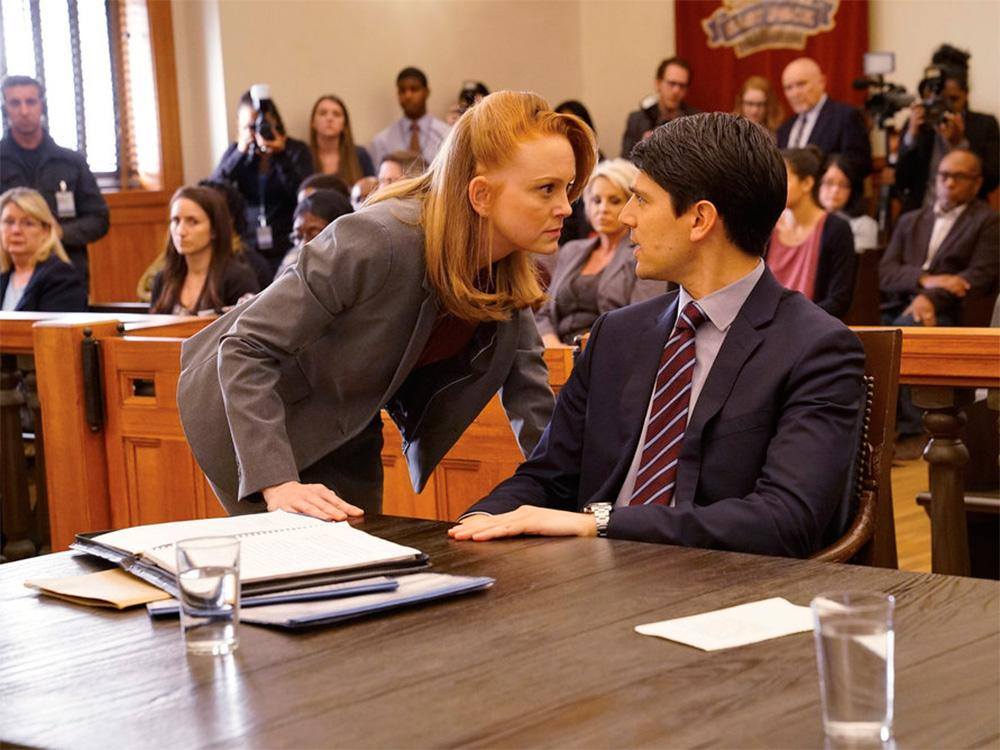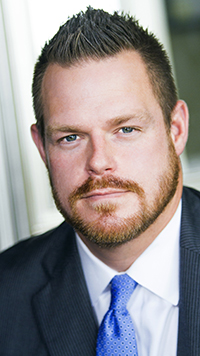Absurdity of courtroom sitcoms like 'Trial & Error' still have elements of reality

Defense attorney Josh Segal and prosecutor Carol Anne Keane, played by Nicholas D’Agosto and Jayma Mays. Photo from Facebook.
Going to court, even to pay a simple parking ticket, causes anxiety and trepidation in most folks. After all, court is where the full weight and power of the government can get dropped on you like an Acme Brick from an old Looney Tunes episode.
Still, the line between perception and reality is a wide one. Remember, court is also the place where people search for the truth in order to mete out justice. It’s the place where the injured and victimized seek compensation for their suffering.
Those who don’t make their living in the courtroom don’t know the full story. Courtrooms are places where anger, laughter, tears and the full range of human emotions are on display each and every day. That’s because the people who make the courthouses work are all humans too—no matter your opinion of attorneys, judges, and everyone else who aids in the legal process.
With this in mind, lawyers watching last season’s NBC comedy series Trial & Error, (its second season in production) had to be struck by how outlandish the characters and plotline were. Surprisingly though, the episodes still contained a few nuggets of truth regarding the realities of the practice of law. If you look beyond the punch lines, the series has a ring of truth to it in at least two areas.
A NYC LAWYER IN A SMALL SOUTHERN TOWN
The series pokes fun at reality TV and true crime documentaries. It follows attorney Josh Segal as he makes the transition from a junior associate in a large New York City law firm to his new small-town, solo practice located behind a taxidermist’s shop in South Carolina. The lawyer’s first—and apparently only—client is Larry, a poetry professor suspected of murdering his wife.
The absurdity begins as the lawyer arrives in East Peck, South Carolina, He is met at the airport by a driver holding a sign with the word “lawyer” handwritten on it. Obviously, there aren’t too many attorneys in the area. The driver, who turns out to be a former local police officer (who happens to be a private investigator in addition to running a car service) ends up going to work for Josh.
The truth is that many young attorneys have discovered career opportunities in small towns and rural communities. These regions may offer a lawyer a better chance to set up a new practice or become part of an existing one. Oftentimes, these chances are better than those they might have in the highly competitive job market of large cities and urban areas.
I remember plenty of attorneys who left our metropolitan law school after graduation and returned to their rural hometowns to open up shop. Others took on contracts with the Indigent Defense System and moved to wherever they were needed. It was a perfect opportunity for a brand-new attorney: guaranteed experience and a guaranteed paycheck.
Even though it seems that specialization and complexity are the current trends in law practices, this might not be the career path for some lawyers just starting out or looking to make a change. Small-town practices generally require lawyers to offer a broad range of services, including criminal defense, family law, wills and estates, and business transactions. As Josh Segal learns in Trial & Error, practicing law in a small town or rural area offers challenges as well as opportunities.
However, some of those challenges and opportunities are too much for even an experienced practitioner focusing on one area of law. Josh makes the same mistake as many attorneys hanging their own shingle: He treads out into the deep end before he’s really even learned to swim. He gets in over his head by taking on the defense of an eccentric individual charged with capital murder as his very first case in private practice.
SPOILER ALERT: THE EVIDENCE DOES NOT ALWAYS LEAD TO THE TRUTH
Here’s a spoiler alert for anyone planning to watch the first season of Trial & Error before the new one begins. The mystery surrounding the death of Professor Larry Henderson’s wife has twists and turns built into every episode, including infidelity, multiple potential suspects, and a defendant whose actions and statements certainly make it appear as though he’s guilty.
Evidence and the facts it proves may not, as the series reveals in its season finale, be the truth those in the courtroom are supposed to seek. The jury verdict after only a few minutes seemed consistent with the available evidence. I’ve been on both sides of short jury deliberations, so I know those happen for better or worse.
Professor Henderson was not, in fact, the murderer, but neither were any of the other suspects. The “killer” was not a person at all. Mrs. Henderson died when she fell through a glass door after being hit by a flying owl.
A man was almost convicted for the actions of a bird. Imagine that.
In criminal defense, sometimes the prosecution is wrong. Prosecutors aren’t perfect, and to a certain extent they are constrained by the available facts. Many times, there is no clear perpetrator established by direct evidence. Consequently, criminal cases are often constructed on circumstantial evidence.
The problem is that circumstances can be compelling. Jury instructions inform fact-finders there is no difference in the evidentiary weight given to direct evidence as opposed to circumstantial evidence. When a crime is committed, especially something as serious as murder, the prosecution has an obligation to try and bring justice to the victims and their families. Sometimes the circumstances lead to the wrong person, and sometimes the wrong person gets convicted.
IMPLEMENTING MEASURES TO AVOID WRONGFUL CONVICTIONS
Since its creation in 1989, the National Registry of Exonerations has recorded 2,182 wrongful convictions that were eventually overturned because of DNA or other evidence showing the individual did not commit the crime. On average, the exonerees spent 8.8 years in prison before being released.
Sure, many might think those 2,000-plus exonerations were simply the result of bad lawyering or unethical tactics that resulted in a guilty verdict. That couldn’t be further from the truth, though. In fact, even cases where the evidence against the accused seems strongest haven’t been immune to wrongful convictions. According to the Innocence Project, 70 percent of exonerations involved cases in which eyewitness testimony was used to obtain a conviction.
Some attribute wrongful convictions to a “convict at any cost” mentality. Plenty of prosecutors take their cases too personally, and they do whatever they can to “get the bad guy.” However, the disappointment displayed by the prosecutor in Trial & Error after seeing her conviction disappear is not always the reaction. There are also plenty of prosecutors who simply want to see justice served. For example, conviction review units have been set up by prosecutors throughout the U.S. for the sole purpose of making certain that wrongful convictions are identified and corrected.
LIFE IN EAST PECK MAY NEVER BE THE SAME
The second season of Trial & Error promises to be as funny and entertaining as the first. From the looks of it, there will be yet another murder in East Peck and a new person to defend.
Broadway star Kristen Chenoweth will take on the role of season 2’s accused. Of course, there wouldn’t be a series if Josh Segal and his team of locals weren’t heading up the defense.

Adam Banner
Adam R. Banner is the founder and lead attorney at the Oklahoma Legal Group, a criminal defense law firm in Oklahoma City. Mr. Banner’s practice focuses solely on state and federal criminal defense. He represents the accused against allegations of sex crimes, violent crimes, drug crimes, and white collar crimes.
The study of law isn’t for everyone, yet its practice and procedure seems to permeate pop culture at an increasing rate. This column is about the intersection of law and pop culture in an attempt to separate the real from the ridiculous.
Updated at 9:36 a.m. to clarify headline.



